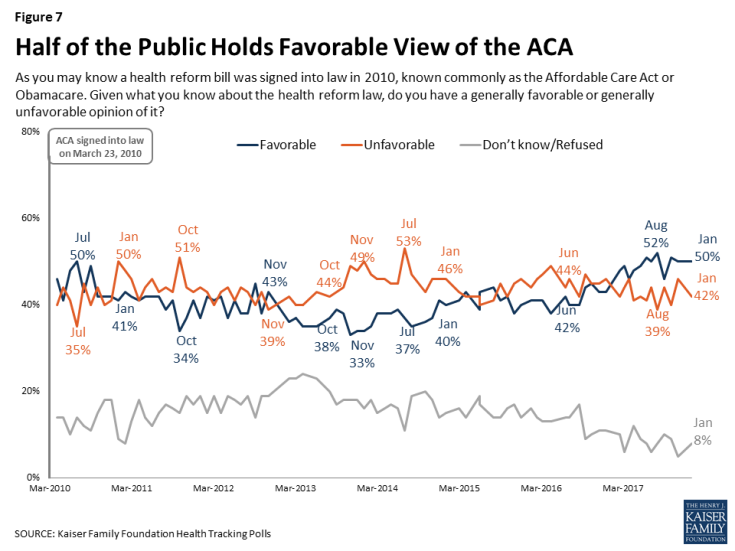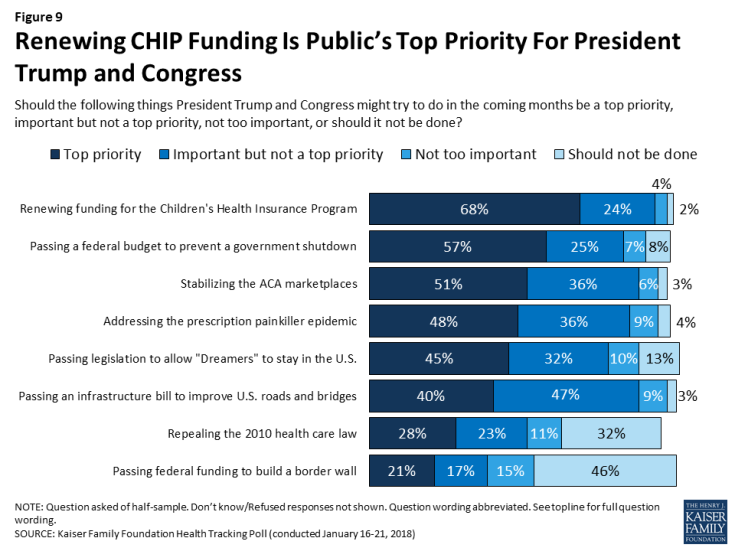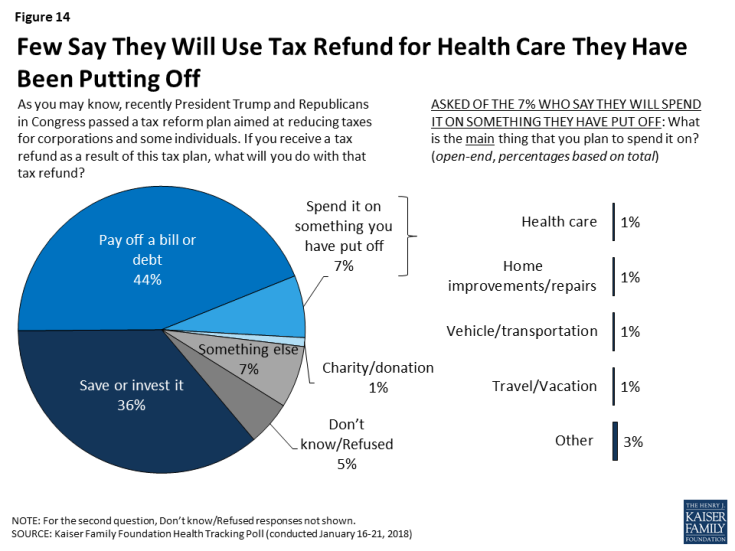Kaiser Health Tracking Poll – January 2018: The Public’s Priorities and Next Steps for the Affordable Care Act
KEY FINDINGS:
- Health care is at the top of a group of issues that voters want 2018 midterm candidates to talk about, but it’s a much higher priority for Democratic voters (39 percent) and independent voters (32 percent) than Republican voters (13 percent); and a lower priority than other issues among voters living in areas where there are competitive 2018 House, Senate, or Governor races.
- The current debate in Congress is about passing a budget to keep the government funded beyond February 8, 2018, in return for a deal on immigration policy and the Deferred Action for Childhood Arrivals (DACA). Providing federal funding for President Trump’s plan to build a border wall between the U.S. and Mexico ranks the lowest (21 percent) among the public’s priorities for the president and Congress, well behind other health-related priorities as well as passing DACA legislation. Passing federal funding for a border wall is tied for fourth (of eight priorities) among Republicans (43 percent).
- As Congress continues to work on a federal budget, some lawmakers have suggested making cuts to government programs such as Medicare and Medicaid. This poll finds that language can matter in framing questions about government spending on such programs. About one in ten say they want to see Congress decrease spending on Medicare (7 percent) and Medicaid (12 percent). When the public is asked about government spending using broader terminology like “welfare programs” or “entitlement programs” rather than a specific name, larger shares of the public say they want to see spending decrease (32 percent and 27 percent, respectively).
- Most believe Medicaid is primarily a government health insurance program that helps people pay for health care while one-fourth (27 percent) believe it is primarily a welfare program. There are partisan differences; overwhelming majorities of Democrats (82 percent) and independents (72 percent) say it is a government health insurance program, while Republicans are divided with about half (51 percent) saying it is a government health insurance program and about half (46 percent) saying Medicaid is primarily a welfare program.
- In light of the recent tax reform legislation passed by President Trump and Congress, the January Kaiser Health Tracking Poll asks the public what they would do with a tax refund. Four in ten (44 percent) say they would use their tax refund to pay off a bill or debt and about one-third say they would save or invest it. Fewer – 7 percent – say they would spend it on something they have put off, including 1 percent who say they would use it on health care they have been putting off.
2018 Midterm Elections
With the 2018 midterm elections still about ten months away, the January Kaiser Health Tracking Poll finds health care among the top issues American voters want 2018 candidates to talk about during their upcoming campaigns. When asked how important a series of major national issues are for 2018 congressional candidates to talk about, similar shares of registered voters say health care (29 percent) and the economy and jobs (27 percent) are “the most important issue.” This is closely followed by immigration (24 percent) and the situation in North Korea (24 percent). Fewer registered voters say “the most important issue” for congressional candidates to discuss are taxes and tax reform (19 percent), the federal budget deficit (17 percent), and climate change (12 percent).
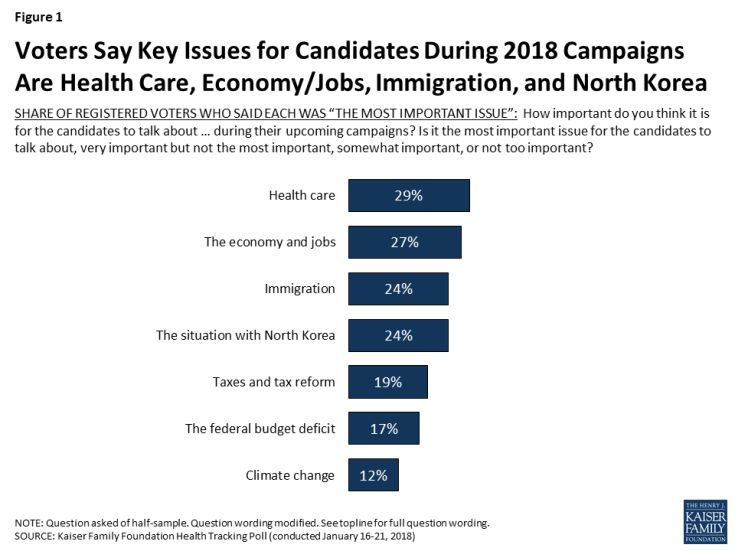
Figure 1: Voters Say Key Issues for Candidates During 2018 Campaigns Are Health Care, Economy/Jobs, Immigration, and North Korea
Democratic voters are more focused on health care (39 percent) than Republican voters (13 percent), while one-third of independent voters (32 percent) say health care is the “most important issue” for congressional candidates to talk about during their campaigns. For Republican voters, the top issue they want to hear congressional candidates talk about is the situation with North Korea (31 percent), followed by immigration (27 percent) and the economy and jobs (25 percent).
| Table 1: Views of Top Issues for 2018 Candidates by Party Identification | ||||||
| Percent who say each of the following is the most important issue for congressional candidates to talk about in their upcoming campaigns: | All Voters | Party ID | ||||
| Democratic Voters | Independent Voters | Republican Voters | ||||
| Health care | 29% | 39% | 32% | 13% | ||
| The economy and jobs | 27 | 30 | 26 | 25 | ||
| The situation with North Korea | 24 | 23 | 20 | 31 | ||
| Immigration | 24 | 22 | 24 | 27 | ||
| Taxes and tax reform | 19 | 22 | 14 | 16 | ||
| The federal budget deficit | 17 | 17 | 16 | 14 | ||
| Climate change | 12 | 19 | 11 | 1 | ||
Voters in Battleground Elections
While health care is among the top issues for voters nationwide, it ranks lower among voters living in areas where there are competitive House, Senate, or Governor races. Voters in areas with competitive elections are more likely to prioritize candidates talking about the economy and jobs (34 percent) than other issues. One in five say the situation with North Korea (23 percent), immigration (22 percent), and health care (21 percent) are the most important issues for candidates to discuss.
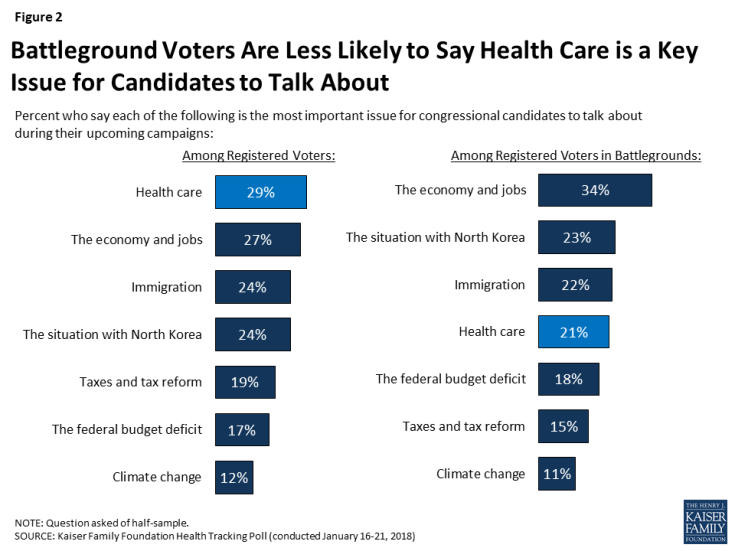
Figure 2: Battleground Voters Are Less Likely to Say Health Care is a Key Issue for Candidates to Talk About
2018 Midterm Election Analysis
As part of Kaiser Family Foundation’s effort to examine the role of health care in the 2018 midterm elections, throughout the year we will be tracking the views of voters – paying special attention to those living in states or congressional districts in which both parties have a viable path to win the election. This group, referred to in our analysis as “voters in battlegrounds” is defined by the 2018 Senate, House, and Governor ratings provided by The Cook Political Report. Congressional and Governor races categorized as “toss-up” were included in this group. A complete list of the states and congressional districts included in the comparison group is available in Appendix A.
The Affordable Care Act
This month’s Kaiser Health Tracking Poll examines awareness of the recent repeal of the Affordable Care Act’s (ACA) individual mandate and the most recent open enrollment period, as well as views of who is most responsible for the 2010 health care law moving forward.
Public Awareness of the Repeal of the ACA’s Individual Mandate
As part of the Republican tax reform plan signed into law at the the end of 2017, lawmakers eliminated the ACA’s requirement that nearly all individuals have health insurance or else pay a fine, known commonly as the individual mandate. The tax plan reduced the individual penalty for not having health insurance to zero beginning in 2019, effectively repealing the least favorable provision of the ACA (according to polling conducted by Kaiser Family Foundation). This month’s Kaiser Health Tracking Poll finds that one-third of the public (36 percent) are aware that Congress has a passed a law repealing this requirement while about half (46 percent) incorrectly say that the requirement has not been repealed. Another one in five (18 percent) are unsure of whether the individual mandate has been repealed or not. The results are similar when we look at those who are more likely to be impacted by this legislative change – the uninsured and those who buy their insurance through the individual market under the age of 65. Among this group, about four in ten (37 percent) are aware the individual mandate has been repealed, while 44 percent say it has not been repealed and 19 percent are unsure.
On the other hand, a majority of the public (68 percent) are aware that the ACA is still in effect, while one in five (17 percent) say it has been repealed and is no longer in effect and 14 percent are unsure.
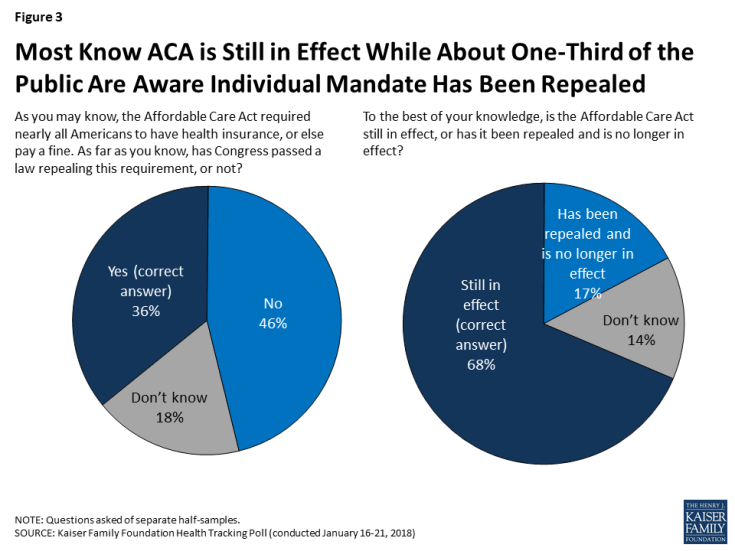
Figure 3: Most Know ACA is Still in Effect While About One-Third of the Public Are Aware Individual Mandate Has Been Repealed
The ACA’s Fifth Open Enrollment Period and Individual Marketplaces
The ACA’s fifth open enrollment period, the time period that individuals who purchase health plans on their own can shop for insurance, ended for most people on December 15, 2017. About four in ten (39 percent) say they heard or read at least some about the open enrollment period, while six in ten say they heard or read either “a little” (31 percent) or “none at all” (29 percent).
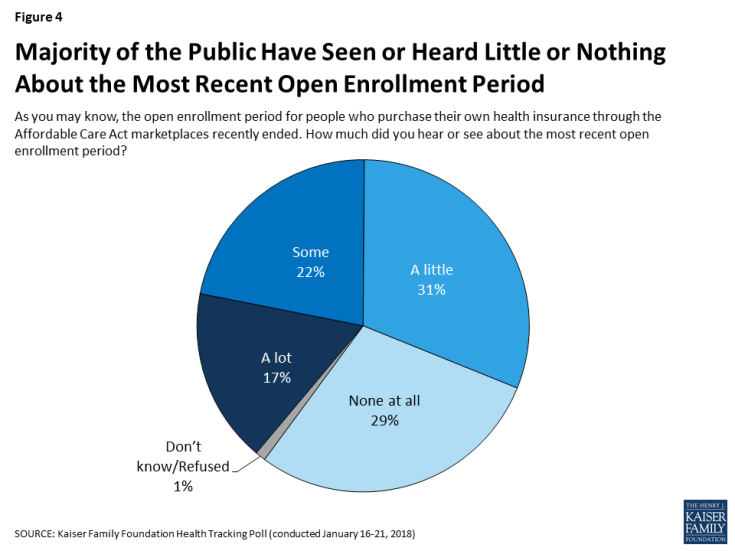
Figure 4: Majority of the Public Have Seen or Heard Little or Nothing About the Most Recent Open Enrollment Period
According to the Centers for Medicare and Medicaid Services, nearly nine million people have signed up for insurance through the federal marketplace,1 which is 400,000 fewer than the number of people that signed up during the previous enrollment period.2 The public is divided in its perception of whether more or fewer people signed up for health insurance during the most recent open enrollmend period. About one-third (36 percent) say more people signed up (including about one in five who said “a lot more”) during open enrollment, while a similar share (31 percent) say fewer signed up (including 13 percent who said “a lot fewer”).
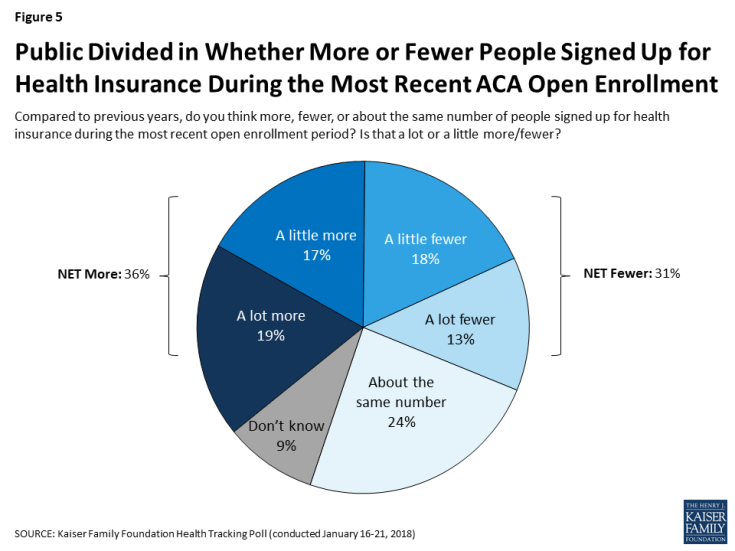
Figure 5: Public Divided in Whether More or Fewer People Signed Up for Health Insurance During the Most Recent ACA Open Enrollment
Perceptions of how the most recent open enrollment period went are largely driven by party identification. Democrats and independents are more likely to say more (either “a lot” or “a little”) people signed up this year than in previous years (43 percent and 37 percent, respectively) compared to Republicans (24 percent).
Overall, the share of the public who think the individual marketplaces are collapsing has decreased from September 2017 (down to 42 percent from 50 percent).
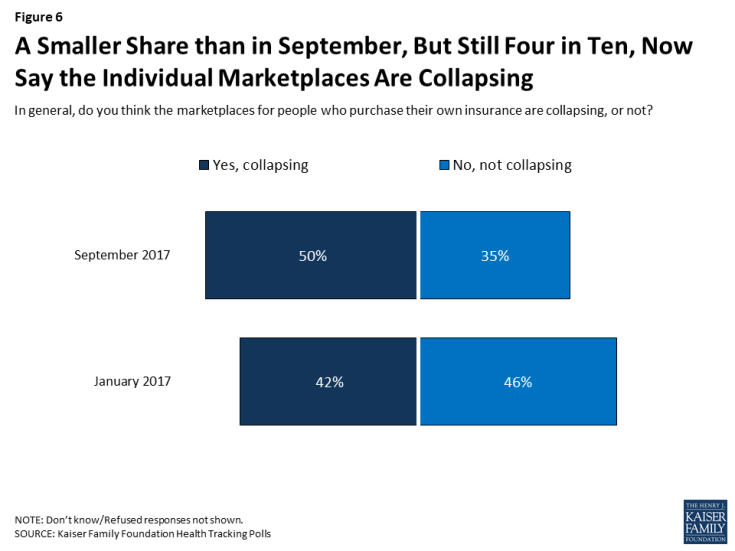
Figure 6: A Smaller Share than in September, But Still Four in Ten, Now Say the Individual Marketplaces Are Collapsing
The Future of the Affordable Care Act
At the start of 2018, the public is more favorable in their views of the ACA, with 50 percent saying they have a favorable view and 42 percent saying they have an unfavorable view. This continues the trend of a larger share of the public holding favorable views rather than unfavorable ones first measured during the Republican efforts to repeal the ACA during 2017.
The majority of the public (61 percent) say since President Trump and Republicans in Congress have made changes to the ACA, they are responsible for any problems with it moving forward, compared to about three in ten (27 percent) who say that because President Obama and Democrats in Congress passed the law, they are responsible for any problems with it. Partisan differences continue, with majorities of Democrats and independents saying President Trump and Republicans are responsible for any problems with it moving forward while a larger share of Republicans say President Obama and Democrats are responsible for the law moving forward.
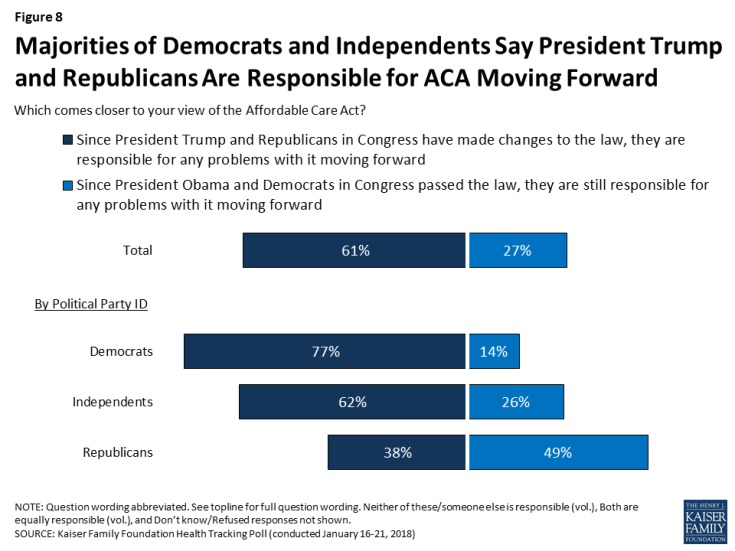
Figure 8: Majorities of Democrats and Independents Say President Trump and Republicans Are Responsible for ACA Moving Forward
Current Priorities for President Trump and Congress
In terms of how the public views the legislative priorities for President Trump and Republicans in Congress, passing federal funding for President Trump’s plan to build a border wall between the U.S. and Mexico ranks the lowest among the public (21 percent) – considerably lower than passing a federal budget to prevent a government shutdown (57 percent), stabilizing the ACA marketplaces where people who don’t get health insurance through their employer can buy coverage (51 percent), addressing the prescription painkiller addiction epidemic (48 percent), and passing legislation to allow Dreamers to stay in the U.S. (45 percent). Despite the recent attention given to Republican efforts to repeal the 2010 Affordable Care Act (ACA), about three in ten (28 percent) say this should be a top priority for President Trump and Congress in the coming months.
Across all Kaiser Family Foundation polling during the fall 2017 renewing funding for the Children’s Health Insurance Program (CHIP) consistently ranked at the top of the public’s priorities, including in this month’s Kaiser Health Tracking Poll (68 percent say it should be a “top priority”). Congress agreed to a six-year extension of the CHIP program as part of the continuing resolution passed on January 22, 2018.
Partisans Hold Differing Views on Top Priorities
Besides all partisans prioritizing passing legislation to prevent a government shutdown, views of what should be the top priorities for the President and Congress vary sharply across partisans. A majority of Democrats want President Trump and Congress to focus on passing legislation to allow Dreamers to legally stay in the U.S. (66 percent), stabilizing the ACA marketplaces (61 percent), and addressing the prescription painkiller addiction epidemic (54 percent).
| Table 2: Views of Top Priorities by Party Identification | ||||||
| Percent who say each of the following should be a top priority for President Trump and Congress: | Total | Party ID | ||||
| Democrats | Independents | Republicans | ||||
| Renewing funding for the Children’s Health Insurance Program (CHIP) | 68% | 84% | 69% | 48% | ||
| Passing a federal budget to prevent a government shutdown | 57 | 55 | 57 | 61 | ||
| Stabilizing the ACA marketplaces | 51 | 61 | 48 | 42 | ||
| Addressing the prescription painkiller addiction epidemic | 48 | 54 | 50 | 43 | ||
| Passing legislation to allow “Dreamers” to legally stay in the U.S. | 45 | 66 | 40 | 21 | ||
| Passing an infrastructure bill to improve U.S. roads and bridges | 40 | 39 | 40 | 41 | ||
| Repealing the 2010 health care law | 28 | 17 | 25 | 48 | ||
| Passing federal funding to build a border wall | 21 | 5 | 19 | 43 | ||
On the other hand, Republicans are more likely to prioritize repealing the ACA (48 percent), addressing the prescripton painkiller epidemic (43 percent), passing federal funding to build a border wall (43 percent), stabilizing the ACA marketplaces (42 percent), and passing an infrastructure bill (41 percent) than they are to prioritize legislation to allow Dreamers to stay in the U.S. (21 percent).
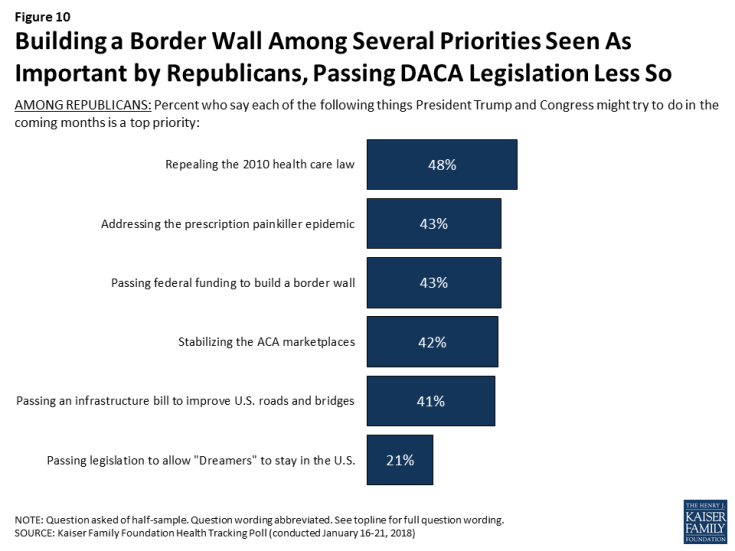
Figure 10: Building a Border Wall Among Several Priorities Seen As Important by Republicans, Passing DACA Legislation Less So
Few Support Reducing Federal Funding for Government Programs
As Congress continues to work on a federal budget, some lawmakers have suggested making cuts to government programs such as Medicare and Medicaid. Few Americans – regardless of party identification – want to see Congress decrease spending on Social Security (5 percent), Medicare (7 percent), or Medicaid (12 percent). This is similar to the share who want to see Congress decrease spending on education (7 percent) and smaller than the share who want to see Congress decrease spending on national defense (19 percent) or foreign aid (43 percent). Large shares want to see spending on all of these government programs say about the same.
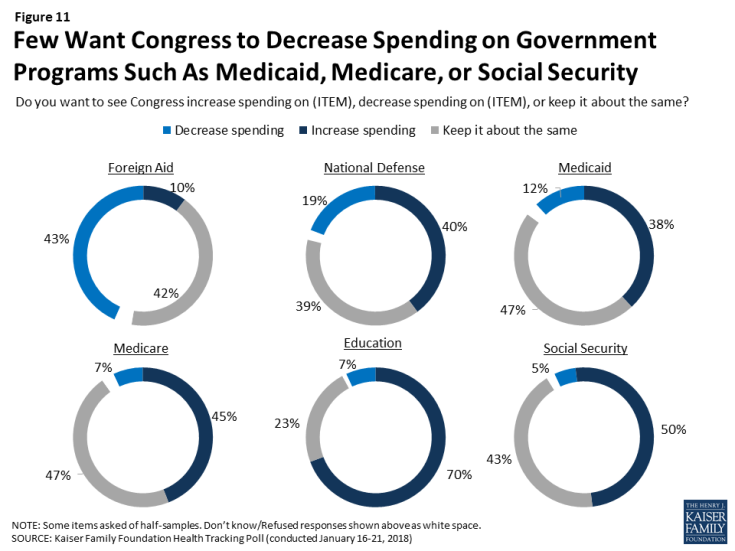
Figure 11: Few Want Congress to Decrease Spending on Government Programs Such As Medicaid, Medicare, or Social Security
Support for Government Program Spending Can Change Depending on What You call It
This month’s Kaiser Health Tracking Poll finds that language can matter in framing questions about government spending on programs like Medicare and Medicaid. As noted above, four in ten say they want to see Congress increase spending on Medicare (45 percent) and Medicaid (38 percent), while about one in ten want to see Congress decrease spending on these programs (7 percent and 12 percent, respectively). When the public is asked about government spending using broader terminology like “welfare programs” or “entitlement programs” rather than a specific name, larger shares of the public say they want to see spending decrease (32 percent and 27 percent, respectively).
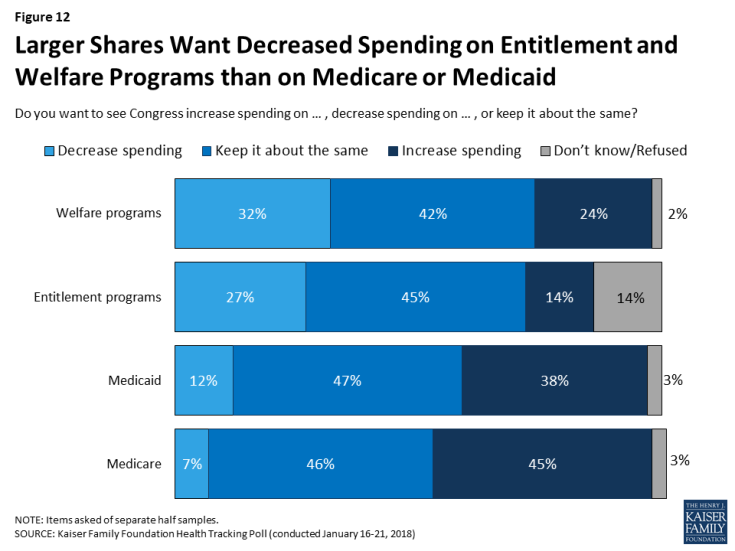
Figure 12: Larger Shares Want Decreased Spending on Entitlement and Welfare Programs than on Medicare or Medicaid
A larger share of Republicans say they would like Congress to decrease spending on welfare programs (58 percent) and entitlement programs (51 percent) than either independents (30 percent and 25 percent, respecitvely) or Democrats (11 percent for both).
Overall, the majority of the public (69 percent) believe Medicaid is primarily a government health insurance program that helps people pay for health care while one-fourth (27 percent) believe it is primarily a welfare program. There are partisan differences with overwhelming majorities of Democrats (82 percent) and independents (72 percent) saying it is a government health insurance program, while Republicans are divided with half (51 percent) saying it is a government health insurance program and about half (46 percent) saying Medicaid is primarily a welfare program.
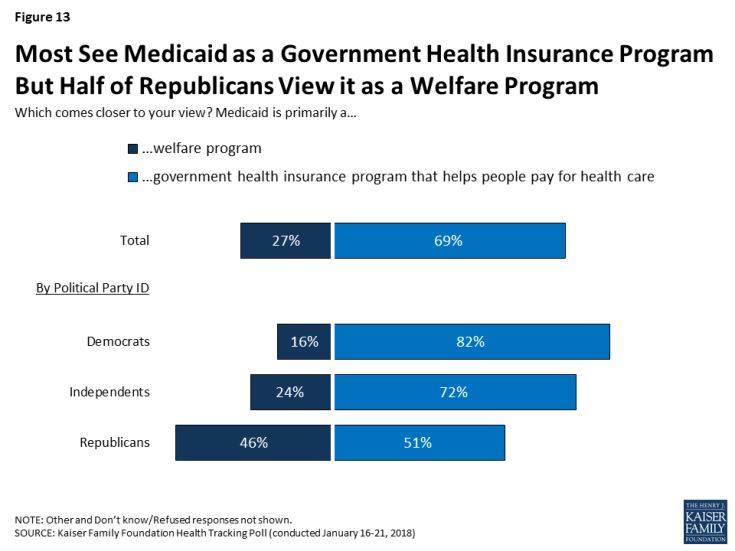
Figure 13: Most See Medicaid as a Government Health Insurance Program But Half of Republicans View it as a Welfare Program
Few Americans Say They Would Use A Tax Refund On Health Care They Have Been Putting Off
In light of the recent tax reform legislation passed by President Trump and Congress, the January Kaiser Health Tracking Poll asks the public what they would do with a tax refund. Four in ten (44 percent) say they would use their tax refund to pay off a bill or debt and about one-third (36 percent) say they would save or invest it. Fewer – 7 percent – say they would spend it on something they have put off, including 1 percent who say they would use it on health care they have been putting off.

